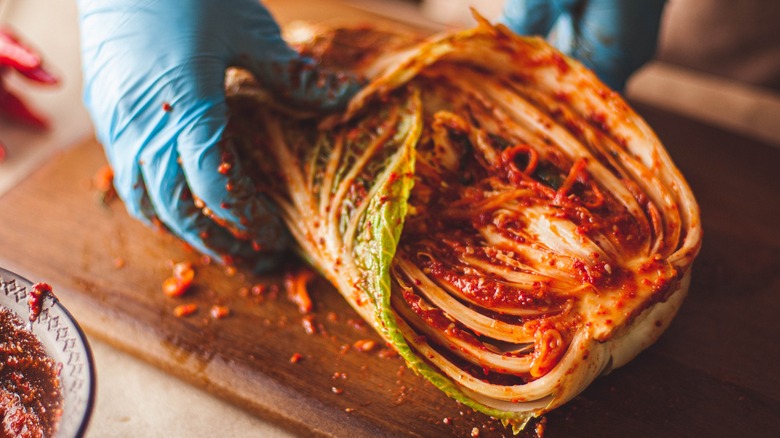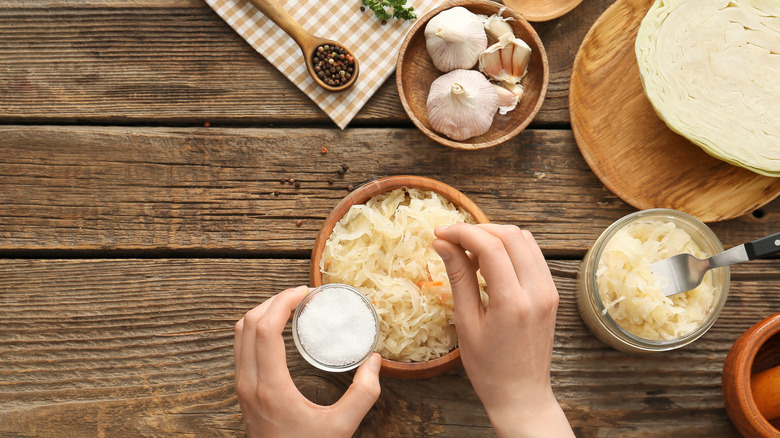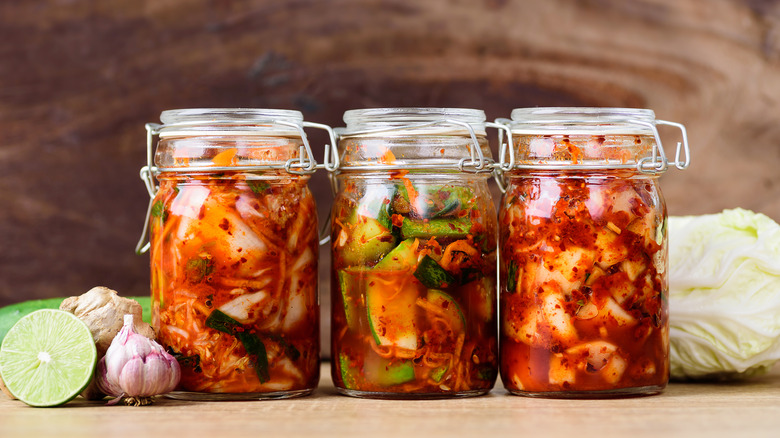The Biggest Difference Between Sauerkraut And Kimchi
Sauerkraut and kimchi may seem similar at first glance, but they actually have very little in common. Their only common denominator is fermented cabbage, one of the best sources of probiotics. The ingredient supports gut health, immune function, and cell production, according to 2021 research published in the journal Nutrients.
As the scientists note, both kimchi and sauerkraut are functional foods rich in vitamins, minerals, and beneficial bacteria. However, they have different origins and nutritional profiles. For starters, kimchi is a Korean side dish made with Chinese cabbage and other raw vegetables. Most recipes also call for fermented seafood sauce and spices such as ginger, garlic, chili peppers, or scallions. Sauerkraut, on the other hand, originates in China and has few ingredients, mainly white cabbage, salt, and some spices. Both foods promote digestive health and fight inflammation, among other health benefits.
From a culinary standpoint, kimchi and sauerkraut couldn't be more different. For example, it's uncommon to pair sausages with kimchi, but you wouldn't think twice before serving them with sauerkraut. Each of these fermented foods has a distinct taste, and they're not always interchangeable in recipes.
Sauerkraut and kimchi have different origins
One of the biggest differences between kimchi and sauerkraut lies in their origins. The latter is commonly associated with German culture, but it actually comes from China.
Some historians say sauerkraut was invented by the laborers who built the Great Wall of China, allowing them to preserve the cabbage during the cold winter months. The original recipe called for cabbage, salt, and rice wine. Today, many countries have versions of sauerkraut, such as skābi kāposti in Latvia, savanyú káposzta in Hungary, and kiselo zele in Bulgaria.
Kimchi, meanwhile, originates in South Korea and is considered a symbol of its culture. The recipe dates back to 1145 A.D. and has more than 200 versions, such as kkakdugi kimchi, baek kimchi, and kkaenip kimchi. For example, pa kimchi is made with green onions, whereas kkakdugi kimchi contains fermented white radish. Whole kimchi, or Tongbaechu kimchi, calls for Chinese or napa cabbage, salt, sugar, glutinous rice flour, fish sauce, scallions, and spices.
Each dish has different ingredients
A 2014 review published in the Journal of Ethnic Foods describes kimchi as a "unique food, without anything similar in other countries." Scientists say it has nothing to do with sauerkraut, paochai, jeolimryu, and other fermented cabbage dishes. Although it undergoes the same fermentation process as sauerkraut, it uses different ingredients and has a distinct flavor.
First of all, kimchi isn't limited to fermented cabbage. The primary ingredient can be radish, green onion, Korean garlic chives, cucumbers, or other raw vegetables. Second, most recipes call for dozens of spices, herbs, or even fruits, such as gochugaru (chili flakes), pears, and ginger. Additionally, Korean chefs use whole leaves or chunks of cabbage and other veggies, and some also add fish sauce to kimchi to achieve that sought-after umami flavor, the so-called fifth taste.
By comparison, sauerkraut has only two ingredients: cabbage and salt. You may add caraway seeds, juniper berries, peppercorns, dill, and other extras, but that's a matter of personal preference. The cabbage must be finely shredded and fermented for a shorter time than kimchi.
Kimchi tastes different from sauerkraut
What gives kimchi its distinct flavor is the combination of vegetables, spices, and herbs. Most varieties have a sour, spicy taste, but the flavor may differ based on the ingredients used. For example, some types of kimchi are only consumed in the summer and have a light flavor. Others are rather spicy or bitter, which makes them ideal for the cold winter months.
Sauerkraut has a more acidic taste without the distinct umami flavor of kimchi and other Asian foods. The longer it's fermented, the sourer and tangier it becomes. Overall, it has a more astringent taste, a simpler flavor profile, and a firmer texture than kimchi.
Despite these differences, both foods are versatile, delicious, and easy to prepare. Serve them as side dishes, enjoy them by themselves, or mix them with other ingredients to create unique recipes. You could even try to make sauerkraut pasta, kimchi fried rice, kimchi parathas, Reuben casseroles, and other meals inspired by cuisines from around the world.



